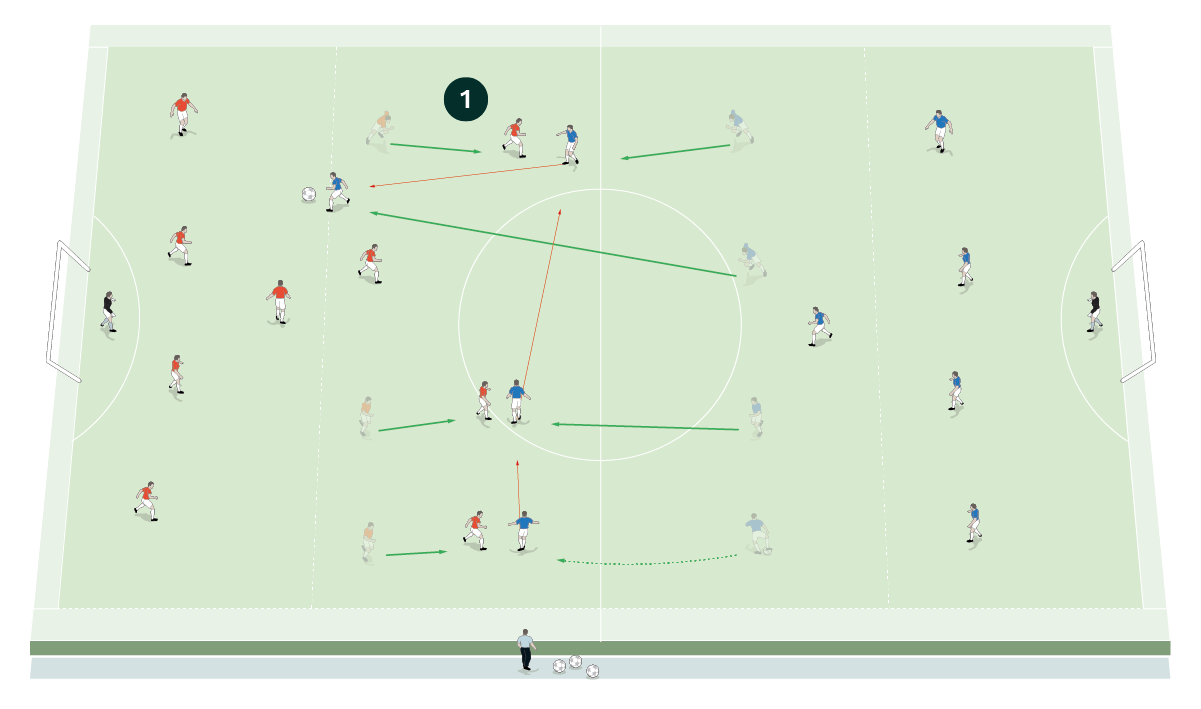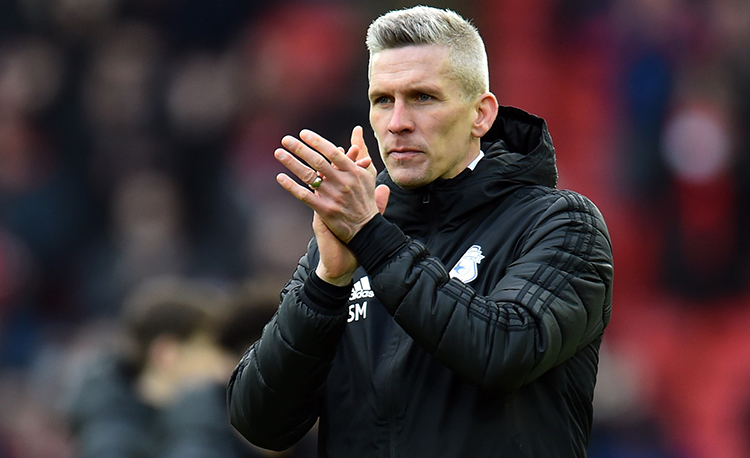You are viewing 1 of your 1 free articles
Managing transitions with and without the ball
| Area | Up to full pitch |
| Equipment | Balls, bibs, cones, poles, 2 full size goals |
| No. of Players | 18 players + 2 goalkeepers |
| Session Time | Transitional rondo: 15mins Transitional possession: 20mins Box to box game: 30mins |
This session is about making decisions in a controlled setting in order to make thinking and problem solving on game day much easier.
This type of session is key to how I want my teams to play. It gets all the players involved in the action and allows everyone to see and feel both sides of the session in a transitional sense.
The training session needs lots of communication between the players to make it work and it has a competitive nature to it. It is also unique as it is fun but with a high intensity workload.
I would run this session in various forms in a week when we only have Saturday to Saturday games. Repetition of the session is the key to its successful progression and the players get better and better at it the more they work at it, which in turn means the decision-making process on game day should be much better.
“This type of session is key to how I want my teams to play. It gets all the players involved in the action”
TRANSITIONAL RONDO
We set up a playing area of 28x12 yards with two 12-yard end zones sandwiching a 4-yard centre zone. One-yard gates are positioned on either side of the centre zone, as shown.
We’re using 18 outfield players split into three teams of six. The reds start in one end zone and the blues start in the opposite end zone, while the yellows begin in the centre zone.
The blue team starts in possession of the ball. Two yellow players from the middle zone are sent into the end zone to press the blue team and they attempt to win the ball. The blue team must make at least three passes before they can try to transfer the ball (below head height) to the red team at the other end – to do this successfully the safest option is to pass the ball down the side of the playing area and through one of the pole gates, where it can’t be intercepted by the yellow players in the middle section, as shown [1a].
[1a]

- The blue team starts in possession of the ball
- Two yellows from the middle zone are sent into the end zone to try to win the ball from the blue team
- The blues must make at least three passes before they can transfer the ball below head height to the reds, preferably by passing through one of the pole gates where it can’t be intercepted by the yellows
They can play the ball anywhere through the centre zone but it is likely to be intercepted by the yellows if the pass is attempted away from the gates.
With the ball now in the red team’s end zone, the two yellow players that pressed the blues return to the centre zone and two other yellows go to press the red team at the other end.
When the red team receives the ball in their end zone they must make a minimum of three passes under pressure from the two yellows before transferring the ball back to the blues, preferably through one of the side gates.
If the yellows block the pass or win the ball, they must clear it out of the area or pass to a yellow in another zone and then a coach serves a new ball back into the blue end zone for play to start again, as shown [1b].
[1b]

- The two yellow players that pressed the blues return to the centre zone
- Two other yellows go to press the red team
- When the reds receive the ball they must make three passes before they can try to pass to the blues, preferably through one of the side gates. If they pass through the middle of the centre zone they could lose possession
- If the yellows block the pass or win the ball, they must clear it out of the area or pass safely to a yellow in another zone
- A coach then serves a new ball back into the opposite end zone to start again
“If the yellows block the pass or win the ball, they must clear it out of the area or pass to a yellow in another zone”
TRANSITIONAL POSSESSION
We set up a playing area of 38x40 yards with a full size goal and goalkeeper positioned at each end. The playing area is made up of two 14-yard end zones and a 10-yard centre zone.
We’re using 18 outfield players split into three teams of six. The reds start in one end zone and the blues start in the opposite end zone, while the yellows start in the centre zone. The blue team begins in possession of the ball and they must complete at least five passes in their end zone before transferring the ball to the red team, using the assistance of the goalkeeper in the build-up if necessary.
The yellow team must press to win the ball back – they can send as many players as they want into the end zone to press and in this instance they use four, as shown [2a].
[2a]

- The blue team begins in possession and they must complete five passes in their end zone before transferring the ball to the red team at the other end
- The possession team can use the help of the goalkeeper in the build-up if necessary
- The yellow team must press to win the ball back. They can send as many players as they want into the end zone to press. Here they send four players
“The blue team begins in possession of the ball and they must complete five passes in their end zone before transferring the ball to the red team”
On receiving the through ball, the red team now aims to complete at least five passes in their end zone. This time the yellow team sends five players to press and win the ball back. If the pressers succeed in winning possession they must quickly attempt to score in the closest goal, so the reactions to winning and losing the ball are key.
Once the ball is dead, the coach serves another ball into the team at the opposite end and the game restarts, as shown [2b].
“We want to see good communication from the pressing players about when and where to press”
[2b]

- On receiving the through ball, the red team now aims to complete at least five passes in their end zone
- This time the yellow team sends five players to press
- If the pressers succeed in winning possession they must quickly attempt to score in the closest goal
- Once the ball is dead, the coach serves another ball into the team at the opposite end and the game restarts
We want to see good communication from the pressing players about when and where to press. We also want to see good communication about the press from the possession team.
We play this for 20 minutes in blocks of two minutes, with one minute’s rest between.
BOX TO BOX GAME
We set up a playing area between the two penalty boxes of the pitch with a goal and goalkeeper at each end. Offside lines are marked out with cones at each end to help with the press.
We’re using 18 outfield players split into two teams of nine plus keeper. A normal game is played but players are encouraged to communicate with each other and organise the press in the same way they had in the previous two practices, as shown [3].
[3]

- A normal 9v9 game is played but players are encouraged to communicate with each other and organise the press in the same way they had in the previous two practices
We want to see calmness and good decision-making on the ball when in possession. We play for 30 minutes in three blocks of eight minutes with two minutes’ rest between.
COACHING POINTS
What are the key things to look out for?
When in possession of the the ball the players need to be calm and concentrate on the first pass and also know when to speed play up or slow it down. This comes from the communication about whether to keep the ball or to play quickly and beat the press by playing to the other side, or to try and create a goal scoring chance.
Without possession, the players really need to communicate and navigate who presses – and how – to try and win the ball back. Do they all go, or do they try and dictate where the other team goes and then win the ball back?
Related Files
Editor's Picks
Deep runs in the final third
Using the goalkeeper in build-up play
Pressing principles
Intensive boxes drill with goals
Penetrating the final third
Creating and finishing
My philosophy
Pressing initiation
Compact team movement
Coaches' Testimonials

Alan Pardew

Arsène Wenger

Brendan Rodgers

Carlos Carvalhal

José Mourinho

Jürgen Klopp

Pep Guardiola

Roy Hodgson

Sir Alex Ferguson

Steven Gerrard
Coaches' Testimonials

Gerald Kearney, Downtown Las Vegas Soccer Club

Paul Butler, Florida, USA

Rick Shields, Springboro, USA

Tony Green, Pierrefonds Titans, Quebec, Canada
Join the world's leading coaches and managers and discover for yourself one of the best kept secrets in coaching. No other training tool on the planet is written or read by the calibre of names you’ll find in Elite Soccer.
In a recent survey 92% of subscribers said Elite Soccer makes them more confident, 89% said it makes them a more effective coach and 91% said it makes them more inspired.
Get Monthly Inspiration
All the latest techniques and approaches
Since 2010 Elite Soccer has given subscribers exclusive insight into the training ground practices of the world’s best coaches. Published in partnership with the League Managers Association we have unparalleled access to the leading lights in the English leagues, as well as a host of international managers.
Elite Soccer exclusively features sessions written by the coaches themselves. There are no observed sessions and no sessions “in the style of”, just first-hand advice delivered direct to you from the coach.









